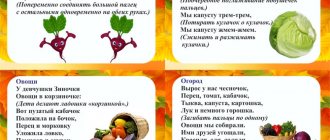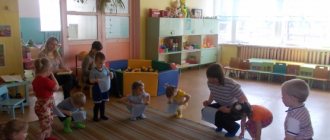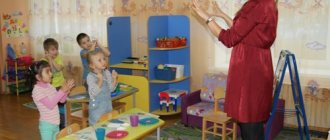Types of finger gymnastics for younger children
Finger gymnastics in the younger group is carried out in the form of a finger game, playing out a fairy tale or nursery rhyme, since ordinary gymnastics, consisting of exercises for the fingers and palms, is still uninteresting and incomprehensible to children.
For children of the third year of life, the most suitable type of games is imitation, in which they imitate animals, fairy tale characters and their actions. For example: “The bun rolled along the path, funny people are running along the path, a bunny is jumping, a bird is flying.”
Manipulation games involving performing certain actions are also popular. They use specially prepared aids (laces, clothespins, caps) with fields to which they are attached. Manipulation includes playing with small objects such as balls, chestnuts, and burying and searching for objects in containers containing bulk materials such as sand or cereal.
There are a number of manipulative games without objects, in which the child needs to perform actions only with his fingers, focusing on the text spoken by the teacher: “This finger is a grandfather,” “The fingers went for a walk.”
From the second half of the year, finger theater can be introduced, acting out a small work or fragment of a favorite fairy tale with the help of finger puppets and small paraphernalia. And even though children cannot yet properly handle puppets or pronounce the words of the roles, looking at theater puppets and performing simple actions with them will be the first step to mastering the art of dramatization.
A finger theater based on a favorite fairy tale will certainly arouse great interest among children
Techniques used in finger games
In many ways, the choice of techniques depends on the stage at which the group teacher is working on finger play during the school year. Conventionally, it can be divided into three stages:
- Introductory (September-November). The teacher’s task at this stage is to arouse children’s interest in finger games and the desire to participate in them, to teach the simplest movements of fingers and palms. The main technique at this stage is direct demonstration, when the teacher takes the child’s hand in his own and directs the actions of his fingers.
- At the second stage (December-February), children are given more independence, they perform play actions, and the teacher pronounces the text of a nursery rhyme, poem or fairy tale. Not all children need direct demonstration anymore, so they introduce methods of explanation, reminders, and demonstration based on a model.
- The third stage (March-May) involves the manifestation of activity and independence of students: they not only perform the movements themselves, but also partially pronounce the text of the game. At the third stage, it is important to support the child’s desire for creativity and improvisation. For this, successful techniques would be asking questions to the child, changing and creatively unfolding the plot of a fairy tale or nursery rhyme used during the game: “The magpie-crow cooked a lot of porridge, fed everyone, because all our fingers are hard-working, well done!” (stroking fingers). The bun rolled and rolled along the path, and hid behind Olechka’s back. Where is Kolobok? You can’t see him, the little fox won’t eat him (the child hides the ball or toy behind his back).” Such creative techniques, in addition to increasing interest in the game, create the prerequisites for the formation of creative and innovative thinking, which will greatly help the child in the future.
The use of visual aids (preferably objects, toys, mitten dolls), artistic expression, and folklore is mandatory at all stages. An indispensable condition is the emotional, correct speech of the teacher. Without encouragement, praise, and support, classes with younger preschoolers are impossible. Even the youngest children should feel like they are in a “success situation.” This will give an incentive, a desire to engage in interesting activities again.
Photo gallery: aids and attributes for finger games with young children
The most suitable for early ages are cap dolls, which are put on like thimbles. Lacing is a type of game with objects in which parts are attached to the base using laces. “Walking” dolls with holes for fingers are used in individual work at an early age. Such relief paths, lined with buttons, develop both coordination and tactile sensitivity. In the sensory box, children, under the supervision of a teacher, can search for and hide a wide variety of objects. Games with Su-Jok massage balls are becoming increasingly popular. Screwing on the caps can also be put into a game plot: the flowers need to pick up the centers If The teacher has established contact with parents; mothers and grandmothers who know how to knit will willingly help in making finger dolls. Bi-ba-bo dolls attract children and allow them to join the wonderful world of theater. By examining scraps of fabric and fur, the child receives a lot of tactile impressions. Walnuts and chestnuts - very comfortable and original material for finger games
Tips for parents
If you decide to start doing finger exercises with your child, then you should consider a few simple rules. They will help make the exercises as beneficial as possible:
- Start learning individual sets of exercises gradually, from simpler to more complex. The main goal is to develop simpler skills, learn individual elements, and then you can move on to more complex exercises.
- Every lesson should be fun and interesting. The baby should think that this is a special game, then he will be happy to repeat it again and again.
- Do gymnastics regularly, but not for too long. Children of this age get tired quite quickly and lose interest in activities.
- It is advisable to repeat each exercise several times, four or five in one session.
- Pay attention to every finger, from big to little finger.
- Try to recite the verses that accompany the exercises by heart rather than reading them from a book.
- Do each exercise yourself, show your child an example.
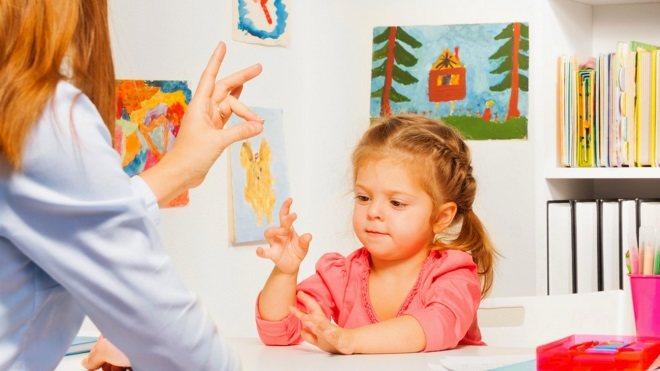
Sources
- https://vospitanie.guru/doshkolniki/zanyatiya-palchikovoj-gimnastikoj-v-detskom-sadu-dlya-detej-3-4-let
- https://sibmama.ru/palchikovie_igri.htm
- https://malchishki-i-devchonki.ru/kartoteka-mladshaya-gruppa-na-temu-palchikovaya-gimnastika-dlya-detej-2-3-let.html
- https://melkie.net/zanyatiya-s-detmi/palchikovaya-gimnastika-v-mladshey-gruppe.html
[collapse]
How to effectively perform finger gymnastics
To achieve a positive result, finger games should be performed regularly. Typically, the effect can be seen after performing 3 or 4 exercises for 5-10 minutes.
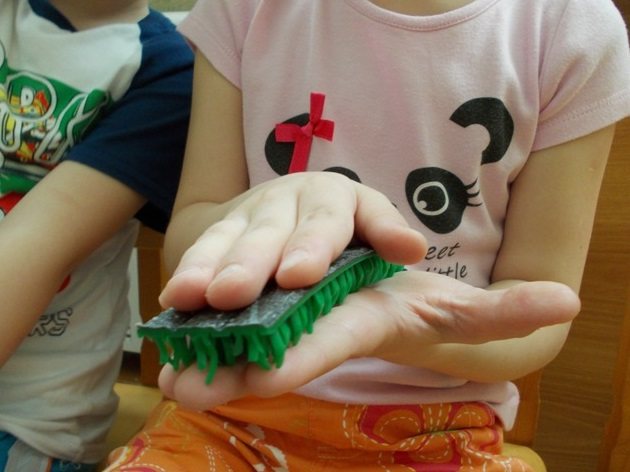
An effective gymnastics method
Often, when sending a child to kindergarten, family members wonder whether it is necessary to constantly change the games in order to maintain interest in them? Children aged 3 to 4 years old love to imitate the movements of adults. This is one of the important mechanisms of learning.
Example of a lesson summary
Body movements and speech have common mechanisms, so the development of fine motor skills of the hands directly affects vocabulary and correct speaking. That is why finger gymnastics according to the Federal State Educational Standards method should be present in classes with the child.
For your information! Children with speech delay have poor coordination of fine motor skills of their fingers. As a result, dysgraphia (writing impairment) may develop.
Improving finger movements will, as it were, prepare the platform for further speech development. The main goal is to start training your baby's fingers as early as possible, for example, in the second or third month of his life.
The teacher can include lessons with the following subjects in the notes:
- Strong palms. The child squeezes rubber toys (the best is a rubber hedgehog, since the needles act as a massager).
- Mosaic. First you need to lay out simple shapes (paths, flowers, squares), and then move on to more complex ones (houses, cars, Christmas trees).
- Constructor. The size of the parts and the complexity of the design depend on the age of the baby. You need to start with the largest parts (for example, building a turret).
- Beads. Their size also depends on the age of the child. First, instead of beads, you can use balls from pyramids with round parts and string them on a thick cord. Then the parts need to be taken less and less each time.
How to conduct classes?
I would like to note that all the finger games were themed. At the beginning of the lesson, a conversation was held on a topic, for example: animals, vegetables, New Year, etc. The game began with me showing the movements, clearly pronouncing all the sounds. Then we repeated the exercise together several times until it was completely memorized. As a rule, my daughter quickly memorized all the games, especially since in kindergarten they repeated these exercises quite often. At the beginning of our classes, the youngest child was about a year old; by the way, he was also interested in watching our games and participated as best he could.
Now the games themselves are from our notebooks.
Counting table
One, two, three, four, five One, two, three, four, five Let's count fingers Strong, friendly, all so necessary On the other hand again One, two, three, four, five Fingers are fast, although not very... clean. (during the exercise, we bend the fingers in turn, first on the left and then on the right hand, on the last lines we wave the fingers of both hands)
Snowball
One, two, three, four (we bend our fingers) You and I made a snowball (we make an imaginary snowball, changing the position of our palms) Round, strong, very smooth (we show a circle, squeeze our palms, stroke) And not at all sweet (we shake our fingers) Let's throw one, catch two (throw and catch an imaginary snowball), drop three and break. (stomp our feet)
Family
This finger is grandpa, This finger is grandma, This finger is daddy, This finger is mommy, This finger is ME, that’s my whole family. (we stroke (rub) each finger, starting with the thumb, and on the last line we make a “lock” from the handles)
Animals
We met two kittens: “Meow-meow!”, Two puppies: “Aw-aw!”, Two foals: Igo-go!”, Two tiger cubs: “Rrr!” Two bulls: “Moo!”. Look at the horns. (for each line, connect alternately the fingers of the right and left hands, starting with the little finger. On the last line, show the horns, extending the index fingers and little fingers.)
Dishes
One, two, three, four (we hit each other with our fists) We washed the dishes (clap our hands) A teapot, a cup, a ladle, a spoon (we bend our fingers, starting with the thumb) And a large ladle We washed the dishes (one palm to the other) Only We broke the cup (we bend our fingers, starting with the thumb) The ladle also fell apart. The nose of the teapot was knocked off. We broke the spoon a little. This is how we helped mom (clap our hands)
Counting vegetables
Lariska has two radishes, Alyosha has two potatoes, Tomboy Seryozhka has two green cucumbers. And Vovka has two carrots, and Petka also has two tailed radishes. (We bend our fingers one by one, starting with the thumb, first on the left hand, then on the right)
Orange
We shared an orange, (clap our hands) There are many of us, but there is only one. This slice is for the hedgehog, (we bend our fingers) This slice is for the swift, This slice is for the ducklings, This slice is for the beaver, And the peel is for the wolf. (we spread our arms to the sides) He’s angry with us, it’s a disaster! (wag a finger) Run away in all directions! (imitate running your fingers on the table)
New Year
In front of us is a Christmas tree (the fingers are intertwined, the index fingers make a Christmas tree) Cones, needles (we show the needles with our index fingers “to the sides”) Balls, lanterns (we show a circle with our thumbs and index fingers) Bunnies and candles (we show our ears) Stars, little men. (fingers intertwined, index fingers made of asterisk)
Snail
The snail pokes with its horns - (the thumb of the right hand holds the middle and ring fingers; the index and little fingers are straight) The gate is locked in the garden (pokes the “horns” into the palm of the left hand) Open the gate quickly, (the left hand “opens” the gate) Let the snail home ( the right hand “creeps”).
Winter forest
A hedgehog, a bear, a badger, a raccoon, They sleep in winter every year. You will find a wolf, a hare and a fox in the forest in winter. (We connect our fingers one by one with each other)
grain
We planted a seed, (we place the seed in our palm with our fingers) The sun came out. (we clench and unclench our fists) Sun, shine - shine! Seed, grow - grow! Leaves appear (we connect our fingers in turn with the thumb on both hands at the same time) Flowers bloom. (clench and unclench your fists)
Ducklings
Five ducklings are swimming forward, Their mother is waiting on the shore, (One of the hands - “mother duck” - stands on the table, leaning on her elbow. The fingers are folded in a pinch. The second hand is the ducklings. We perform wave-like movements towards the “duck”. The number of extensions fingers corresponds to the number of ducklings) But only four ducklings returned to their mother back. (Gradually the fingers are bent) Four ducklings are swimming... Three ducklings are swimming... Two ducklings are swimming... Here is one swimming forward, On the shore his mother is waiting, (To the words “On the shore their mother is waiting “We nod” with our hand (“mother duck”) And at once five ducklings returned to their mother!
Goats
(On both hands we press the middle and ring fingers with our thumbs). Once upon a time, a little goat was visiting someone across a bridge, (We hold our hands horizontally, bring our hands together) And another one walked towards him, He was returning home. (We connect on the first syllable of each line hands in a big way) Two horned stupid brothers began to butt heads on the bridge, Not wanting to give in, And let the other one through. For a long time the goats fought, They ran up and pushed each other. With a running start, they hit their foreheads - bang! (When we hear the word “bang” we clap our hands.) And from the bridge into the water – splash! (We drop our hands on our knees).
Bunny
The bunny was jumping through the forest, (his fingers “jumping” on the table) The bunny was looking for food for himself. (we move the fingers of both hands one by one on the table) Suddenly, on the top of the bunny’s head, the ears rose up like arrows. (we depict ears with our hands) A quiet rustling is heard: Someone is sneaking through the forest. (fingers slowly walk along the table) The hare confuses his tracks, runs away from trouble. (fingers quickly and quickly run in circles on the table)
Snow Pie
Snow fell on the threshold, (slowly hands up and down) The cat made himself a pie. (we press our palms to each other - we make a pie) And while I was sculpting and baking, the pie flowed away in a stream (the fingers of both hands ran across the table) Bake pies for ourselves, (we press our palms to each other - we are making a pie) Not from snow - from flour.
Cam
This finger is small, (bend the little finger) This finger is weak, (bend the ring finger) This finger is long, (bend the middle finger) This finger is strong, (bend the index finger) This finger is fat, (bend the big finger) Well and together - a fist!
On a visit
On a visit to the big finger (the thumb is bent, the rest are clenched into a fist) They came straight to the house: Index and middle, (in accordance with the text, straighten the fingers alternately) Ring and last. The little little finger himself knocked on the threshold. Together, fingers are friends, (clench your fingers into a fist and unclench them) They cannot live without each other.
Cake
We remember the dough with our hands, (we squeeze and unclench our fingers) We bake a sweet cake. (as if we are kneading dough) Lubricate the middle with jam (circular movements with palms on the table) And the top with sweet cream (circular movements with palms against each other) And with coconut crumbs We will sprinkle the cake a little (sprinkle “crumbs” with the fingers of both hands) And then make tea - Invite a friend to visit! (one hand shakes the other)
Maple
The wind quietly shakes the maple, (fingers spread out and stretch up) Tilts to the right, to the left: (we swing our palms right and left) Once - tilt and twice - tilt, (tilt left - right palms low and low) The maple leaves rustled. (move your fingers)
Squirrel
A squirrel sits on a cart (we clap our hands) She sells nuts (we hit each other with our fists) to the little fox-sister (we bend our fingers, one at a time, starting with the big one) to a sparrow, a titmouse, a thick-fisted bear, a big-eared bunny.
Kid
Boo-boo, I'm horned (finger horns) Boo-boo, I'm tailed (tail behind my back) Boo-boo, I'm eared (ears made from palms) Boo-boo, very scary, (finger horns, butting heads) Boo-boo , I'll scare you, Boo-boo, I'll gore you.
Forms of organization of finger games
Finger games with children of the third year of life can be carried out in the form of frontal, subgroup and individual lessons.
Table: features of organizing finger games depending on the form of activity
| Form of organization | Number of children, duration | Key Features |
| Frontal | All children of the group. 7–10 minutes. |
|
| Subgroup | 4–8 people. Up to 7 minutes. |
|
| Individual | 1–3 people. Up to 5 minutes. |
|
| Notes |
|
Structure and time frame of frontal classes in the first junior group:
- Introductory part. Organizing children, creating a positive mood, a surprise or game moment, the appearance of a fairy-tale character. Up to 2 min.
- Main part. Introductory conversation, demonstration of illustrative or other visual material, finger play itself, didactic game. 5–7 min.
- Final part. Summing up, encouraging words from the teacher. Up to 1 min.
Table: card index of works of art for finger gymnastics, developed by R. R. Gainullina
| “Cabbage” We chop and chop the cabbage, We salt and salt the cabbage, We three and three cabbage, We press and press the cabbage. (Move your palms up and down, alternately stroking your fingertips, rub your fist against your fist. Clench and unclench your fists.) | “Turnip” The grandmother and grandfather are pulling and pulling (Pulling fingers by the phalanges of the nails) A large turnip from the ground: If only our granddaughter would come, The dog Bug would help. Where is the cat, mouse, baby? (The fingers of the same name touch each other.) At least she held on tight, The turnip was stretched out. |
| “Adults and children are happy” Who else is enjoying the sun? Grandfather is happy, Grandma is happy, Mommy is happy, Daddy is happy, I am very happy. The whole family is happy about the sun! (Perform the movements according to the teacher’s model: for each line, children bend their finger, line 6 - clench and unclench their fist). | “My family” This finger is my grandfather. This finger is grandma. This finger is daddy. This finger is mommy. This finger is me, that’s my whole family. (As you read, a finger bends on the child’s hand, starting with the thumb). |
| “Hedgehog” The hedgehog stomped along the path and carried mushrooms in a basket. To count the mushrooms, you need to count your fingers. (Children take turns bending the fingers on their left hand, then on their right hand. At the end of the exercise, their hands should be clenched into fists.) | “Helper” Our Antoshka washes the dishes, washes the fork, cup, spoon, (Rub your palms together, “wash the dishes”). I washed the saucer and glass and closed the tap tighter. (Extend your fingers from your fist, starting with the little finger. Perform imitating movements). |
| “Friendship” We bend our fingers together, clench our fists tightly. One, two, three, four, five - (We begin to unbend. Children clench their fingers into fists, and then relax them and unclench them). | “Feet walk along the road” Big feet: Walk along the road. Top-top-top... Little legs Run along the path: Top-top-top. (Four fingers of the right hand tap on the left hand, children repeat the text after adults). |
| “Steamboat” There was a steamboat at sea. (Palms together in a bowl shape). So he sailed to the pier. (Make wave-like movements in the air). He blew his trumpet: “U-u-u!” (Move your thumbs at the same time). | “Horses” Along the white, smooth road, their fingers gallop like horses: Chok-chok-chok. Chok-chok-chok. A frisky herd gallops (Fingers jump on the table, repeating the text after the adults: “chok-chok, chok-chok”). |
Table: summary of GCD in the 1st junior group on speech development using finger games “Nuts for a squirrel”, developed by N. V. Shandina
| GCD stage | Contents of the stage |
| Tasks |
|
| Material | Toys: bunny, bear; squirrel, walnuts; tree layouts. |
| Introductory part | Educator: Children, look what I found. (shows the box). Let's see what's in the box? These are nuts. Listen to the poem here.
Educator: Let us go into the forest and find the one who lost these nuts. |
| Main part | Children "go to the forest." A hare is sitting under a tree. Educator: Look, who is it? What does the bunny have? Children: Ears, paws, tail, eyes. Educator: Bunny, tell us, are you the one who lost the nuts? Hare: No. It's not me. I love carrots. Educator: Guys, let's treat the bunny with a carrot. The outdoor game “The little white bunny is sitting” is played. Children say goodbye to the hare. Educator: Look who is sleeping under the tree in the snowdrift? Children: Bear. Educator: Let's wake up the bear:
Children look at the bear and imitate its movements. Educator: Guys, let's have some fun for the bear. Here I have magic bushings. Didactic game with bushings. Educator: Bear, are you the one who lost the nuts? Bear: No, not me. Maybe a squirrel sitting on a tree. She loves to chew nuts. Educator: Squirrel, weren’t you the one who lost the nuts? Squirrel: Yes, I lost my nuts. Thank you children. Educator: Squirrel, listen to what nursery rhyme we know about you.
Squirrel: Guys, I have a lot of nuts and I want to treat you to them. The children help themselves and thank the squirrel. |
| Final part | Educator: Thank you, but it’s time for us to return to kindergarten. Where have we been, guys? Who did you meet? Today you were very attentive, well done, you had fun playing with the animals. |
